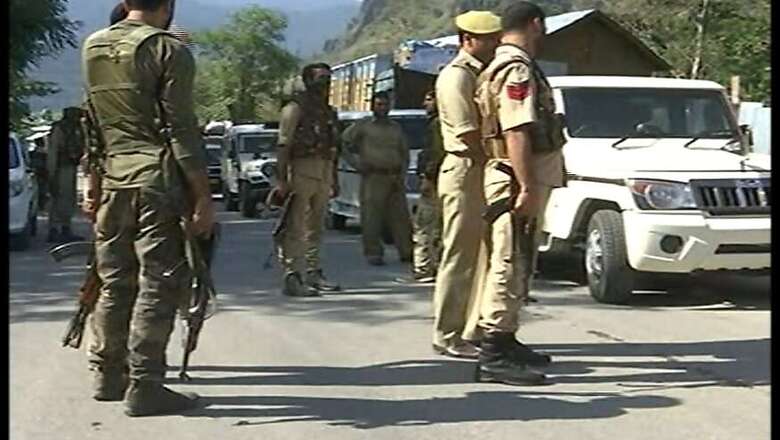
views
The Narendra Modi government, in pursuance of its ‘one nation, one Constitution’ goal, has repealed articles 370 and 35A of the Constitution, thereby taking the final decisive step towards complete legal integration of Jammu and Kashmir with the Union of India.
This constitutional integration leads us to think that we can finally achieve the Utopian concept of India, from Kashmir to Kanyakumari. However, this journey is not the one to be achieved by the repealed articles only.
The fact that the Modi government has got the requisite mandate, political will and vision to take the necessary steps towards bringing in economic development and prosperity as well as people-to-people interaction and integration of the region is contravened by the fact that complete integration of Kashmir with the Union of India cannot materialise with the existence of terrorism and global interference in the region of Jammu and Kashmir.
It’s not that the Kashmir issue is the only internal security concern of India. In the past, India has successfully neutralised the Khalistan movement and has also contained the Maoist rebellion to few regions.
These successes give us valuable insight into how internal security should be approached. An analysis of these movements reveals the state police plays a major leadership role in tackling such problems.
The Khalistan movement was crushed by the state police by neutralising armed separatists in the inner cordons during operations under the leadership of KPS Gill, the then deputy general of police, Punjab, while the Army and Central Armed Police Forces (CAPF) operated in the outer cordon.
The Andhra-Odisha border area is one of India’s worst-hit areas as far as Maoism is concerned. But last five years’ data from the most-affected districts of this region show that Naxalism is at its lowest ebb.
There were 16 civilian killings in Malkangiri district of Odisha in 2015 that came down to six in 2018 and three in 2019 till June 30. Similarly, the number of police personnel killed in 2015 in Malkangiri was three which is reduced to zero in 2018. There has been zero fatalities this year till now.
In Vishakhapatnam, civilian killings in 2010 was 11 which reduced to two in 2018 and one in 2019 till June 30. In Odisha’s Koraput district, civilian killings have been reduced from nine in 2014 to zero in 2018. No such deaths have been registered this year, till now.
Simultaneously, in the last five years, 44 Maoists were neutralised in Malkangiri and 14 in Koraput. The above figures clearly show that the movement has been hit hard in its hotbed. These details also reveal how state police forces like Greyhounds of Andhra Pradesh and Special Operations Group (SOG) of Odisha have been successful in countering the Maoist menace, while Punjab police could do the same against the Khalistan movement.
An analysis of data of the last 10 years in the Andhra-Odisha border shows that 99% of successful encounters and arrests of Maoists have been done by the specialised units of state police forces like Grey Hounds, SOG or District Voluntary Force.
Central Paramilitary Forces conduct mostly area domination exercise and ground-holding activities. The same is true for Punjab where Khalistan Separatist movement was curbed mostly by Punjab Police, while the CAPF or Army operated in the outer cordon.
The second-best reason for success in curbing the Red rebellion in the area is the strategy adopted by the Andhra Pradesh and Odisha governments of putting young IPS officers in the frontline of combat. Most of them were appointed as officers on special duties and superintendents of police in the Maoist-affected areas.
The Jammu and Kashmir Police is one of the most professional combative police forces in the country that operates mostly in the inner cordon during anti-terrorism operations and most of the success stories of eliminating terrorists in the Valley may be attributable to their intelligence and valour.
Now, with the repeal of Article 370 and creation of the Union Territory of Jammu and Kashmir, the subject of police and public order falls exclusively within the domain of the Centre and this provides the Modi government with an opportunity to set up an administrative structure that gives prominent role to the state police in tackling internal security/terrorism issues of the region which may be like this.
(i) State police should play prominent role in managing the situation.
(ii) Co-ordination among various security forces in the region should be done by the state police.
(iii) It should be the lead agency in intelligence sharing.
(iv) Further strengthening and modernising of Jammu and Kashmir Police.
(v) Creation or upgrade of specialised trained units within Jammu and Kashmir Police on the lines of Greyhounds and SOG, though the former has its own SOG unit. These elite units would be better placed to deal tactically with terrorism.
(vi) CAPF may be initially put in area domination and in support system to frontline state police forces so that specialised teams can sustain the operations for a longer period.
(vii) In the long run, after their academy training, young IPS officers may be deputed in the frontline team of CAPF for two-three years as assistant commandants or deputy commandants and lead the operations. The success of state police forces in combat activities in Maoist areas are mainly attributable to the age profile of the state police personnel and young IPS officers of district police or specialised state forces.
(viii) Capacity building of the state police personnel in social media monitoring via which young minds are radicalised and attracted towards ideology of terrorism. Every district should have a well-equipped and active social media cell under the supervision of District Superintendents of Police.
(ix) State police should play pro-active role in educating people on the role played by the Union of India in combating terrorism and bring in good governance to the region. Further, the youth should be made aware of the atrocities committed by terrorists in the region and their modus operandi.
(x) On the border front, the Army needs to enhance its dependence on technology-based solutions, finding the hotspots and working on them, fixing the pores wherever they are and work on innovative intelligence strategies like social media monitoring, wide CCTV coverage and penetration into their cadres.
(The author is former DGP of Odisha who has served in Maoist-hit areas of Odisha and Uttar Pradesh and CAPF in various capacities. Views are personal)













Comments
0 comment